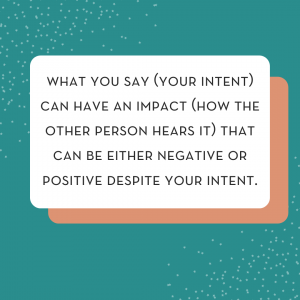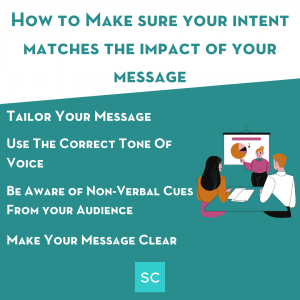Your Communications Intent Vs. Your Impact
What is the difference between the intent of your communication versus the impact of your communication? Let’s think of this scenario: have you ever said something and immediately regretted it? Or, you had to quickly clarify because you could tell it didn’t land the way you intended?
To put it simply, what you said (your intent) can have an impact (how the other person heard it) that you weren’t hoping for.
 For instance, the message you intended to send to your co-workers, despite having no ill intent, was said in a way that made them upset, therefore having a negative impact.
For instance, the message you intended to send to your co-workers, despite having no ill intent, was said in a way that made them upset, therefore having a negative impact.
The truth is: Communication can be tricky!
So how do you make sure that your intention behind what you say has the impact you want?
1. Tailor Your Message
We talk a lot about the messages you are sending when communicating. Whether you are prepping for a pitch meeting, sitting on a video conference call, or having a conversation with your co-worker – your message (what you are actually saying) is so important.
One way that you can make sure that the intention behind your message matches the impact is to tailor your message to the person or audience who will be receiving it. Communicating with impact isn’t always the easiest to learn, but it is possible!
This means, putting yourself in the other person’s shoes and consider the context:
- How would your message feel?
- Does your message put you on the defensive?
- Is there any part of your message that feels accusatory or insensitive?
- What do they know or don’t know?
It’s impossible for you to know exactly what is going on in your audience’s minds, but by trying to tailor your message to them, you are exercising emotional intelligence to help your message land the way you intended.
2. It’s Not What You Say But How You Say It
Sometimes it’s not the actual words that can have the opposite impact, but it’s via our tone of voice. How you say something can change the intent behind your message.
Think back to a time when you were on the receiving end of a message that made you upset. Maybe your boss was pointing out a mistake you made. Or perhaps a co-worker pointed out an error that you made during a meeting. None of this was easy to hear. However, the way it was said just made it feel 100x worse.
No one wants to be on the receiving of this, so be mindful of how you’re speaking. Sometimes it’s even more important than what you are saying.
3. Listen With Your Eyes
Have you ever said something and immediately saw a shift in the room. The energy suddenly changed and people suddenly became shifty? In this case, you are listening and noticing with your eyes.

In other words, you are picking up on the non-verbal cues that your audience is sending you.
When this happens, consider what you’ve just said. Did your audience react the way you intended? If not, you may want to reevaluate your message and how you said it. Chances are your message is not having the impact that you intended and you may end up receiving quite a few emails after the meeting.
4. Focus On Your Message
When preparing your message, truly focus on what your intention is behind what you are saying. And then reverse engineer your message. You want to be sure your message is clear, easy to understand, and that your tone of voice is appropriate.
Ask yourself the following questions to help prep:
- Is my intent reflected within my message?
- Is my tone of voice in line with what I want the impact of my message to be?
- Will what I say be taken the wrong way?
- Am I communicating my message clearly?
When you focus on your message, you are more likely to resolve any negative impacts that it may have.
Of course, there is no way to fully know how someone will take your message. There could be hidden biases. However, as a leader, it is your job to minimize any negative impact that your message may send. We can try and control what we can.
Ensuring that you are clearly communicating and considering others is the core of having your intent match its impact.
__
Whenever you’re ready, there are 3 ways we can help you:
- Discover your communications style so you know where to start. Over 4,000 people have found theirs here.
- Attend our monthly communication workshop to build communications confidence (new topics: public speaking, advocating for yourself, building credibility, etc) here.
- Get your brand in front of 43k+ people by sponsoring our newsletter or Soulcast Media | LIVE LinkedIn events [contact: hello@soulcastmedia.com]











